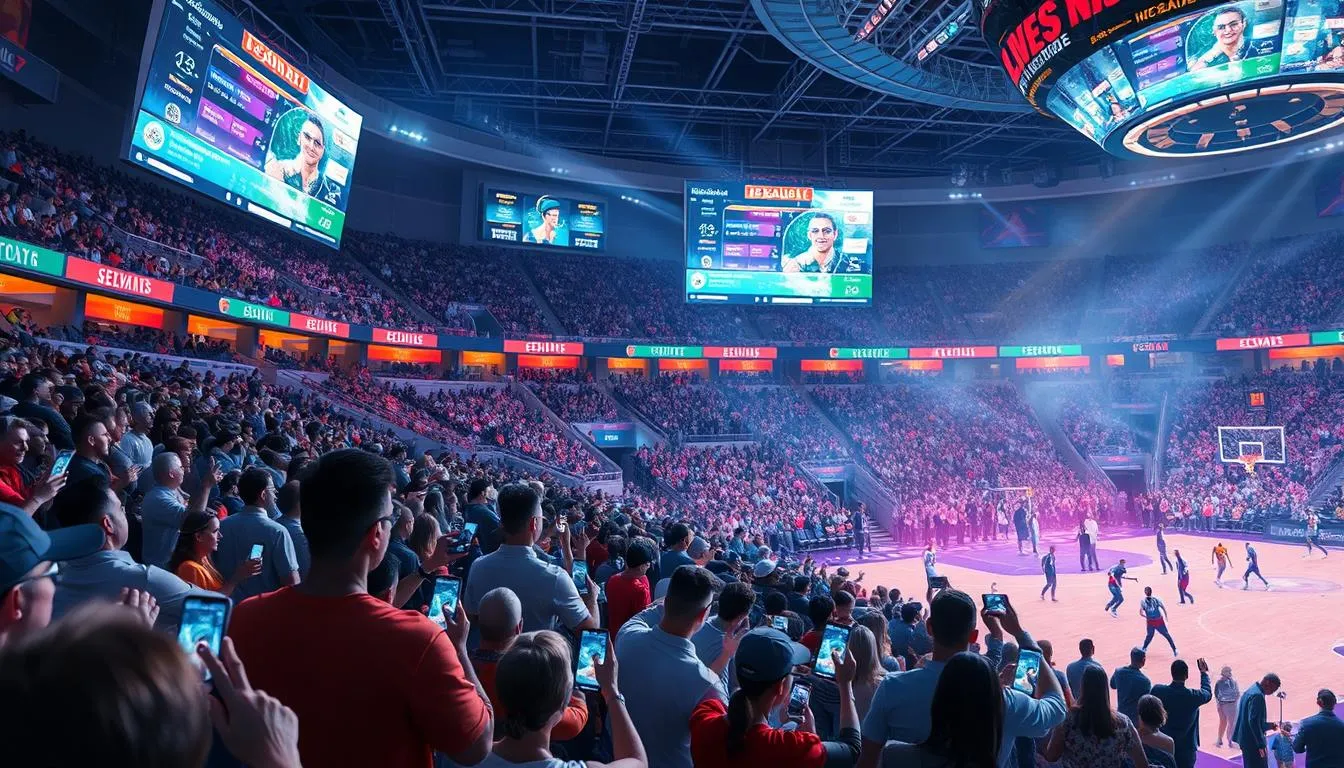Future of US Sports: Trends and Predictions
The United States sports scene is changing fast. The next few years will see big changes in how we watch and play sports. Esports, virtual reality, data analytics, and social media will all play big roles in this shift.
- The Rise of Esports and Virtual Reality
- The Impact of Data and Analytics
- Sports in the USA for 2025 and Beyond: Trends and Predictions
- The Influence of Social Media and Streaming
- The Evolution of Fan Engagement
- The Future of Sports Stadiums and Venues
- The Growth of Non-Traditional Sports
- The Impact of Globalization on US Sports
- The Expansion of International Talent in American Athletics
- The Rise of Global Viewership for US Sports
- The Role of Technology in Officiating
- The Importance of Athlete Health and Wellness
- Conclusion
- FAQ
- What are the key trends shaping the future of sports in the United States?
- How is the sports industry leveraging esports and virtual reality?
- What is the impact of data and analytics on the sports industry?
- How are wearable technology and predictive analytics shaping the future of sports?
- What is the influence of social media and streaming on the sports industry?
- How are teams and leagues enhancing fan engagement?
- What changes are we seeing in sports stadiums and venues?
- What is the growth of non-traditional sports in the United States?
- How is globalization impacting the sports industry in the United States?
- How is technology influencing sports officiating?
- What is the importance of athlete health and wellness in the sports industry?
This article looks at the trends and predictions for sports in the USA. It explores how these changes will affect how we follow our favorite teams and athletes. We’ll see how the sports industry will evolve in the years leading up to 2025.

Key Takeaways
- Esports and virtual reality are poised to revolutionize the sports landscape in the United States.
- Data analytics and predictive technologies will play a crucial role in player development and fan engagement.
- Social media and streaming platforms will become increasingly influential in shaping the sports industry.
- The future of sports stadiums and venues will prioritize immersive experiences and sustainable practices.
- Globalization will drive the expansion of international talent and viewership in American sports.
The Rise of Esports and Virtual Reality
The sports world is changing fast, with esports and virtual reality (VR) leading the way. The esports growth USA is amazing, with pro leagues and big tournaments drawing in young fans. These trends are exciting people all over the United States.
The Growth of Esports Leagues and Tournaments
Recently, the future of esports in America has seen the start of professional leagues. These leagues, like the League of Legends Championship Series and the Overwatch League, are huge hits. They let top gamers compete and connect with fans, showing the huge potential of the esports growth USA market.
The Adoption of Virtual Reality in Sports Experiences
The virtual reality sports industry is also booming, bringing fans closer to the action. With VR, you can feel like you’re right there at a game or in a race. This technology is making sports more immersive and exciting for everyone.
| Esports Leagues | Viewership (2022) |
|---|---|
| League of Legends Championship Series | 2.1 million |
| Overwatch League | 1.5 million |
| Call of Duty League | 1.3 million |
The Impact of Data and Analytics
In the world of American sports, data and analytics play a big role. Teams and leagues use advanced tools to improve player performance and fan experience. They also make better decisions with the help of data.
Data analytics has changed sports forever. Teams find patterns and talent with predictive analytics. This technology in American athletics helps coaches and managers make better plans for players.
Data also changes how fans enjoy sports. Leagues and teams use data to understand fans better. They create more engaging experiences with personalized content and real-time analysis.
The use of predictive analytics in sports will grow. Teams will make smarter decisions with advanced data models. The future of sports is linked to data and analytics.
“Data is the new currency in sports, and those who can harness its power will have a significant competitive advantage.”
| Key Benefits of Data Analytics in Sports | Examples of Data-Driven Insights |
|---|---|
|
|
Sports in the USA for 2025 and Beyond: Trends and Predictions
The sports world is changing fast, and the USA is leading this change. We’re seeing more wearable tech sports USA and predictive analytics player development. These changes will change American sports forever.
The Integration of Wearable Technology
Wearable devices are already big in sports, giving athletes and coaches key data. Soon, we’ll see even more use of these technologies. This will lead to better training and injury prevention.
From sensors to smart fabrics, the future of sports technology in America looks bright. It will make sports better for athletes and help them grow.
The Use of Predictive Analytics in Player Development
Data and analytics are key in sports now. Predictive analytics player development helps teams understand athletes better. It shows their strengths and what they need to work on.
This info helps create custom training plans. It also finds and grows young talent. As analytics get better, so will how teams pick and train players.
The mix of wearable tech sports USA and predictive analytics player development is exciting. It’s part of a bigger trend in future of sports technology in America. Fans can look forward to new tech, better athletes, and more fun games.
The Influence of Social Media and Streaming
Sports have changed a lot with social media and streaming. Fans now interact with their favorite teams and athletes in new ways. The sports world has had to quickly adjust to these changes.
The Emergence of Athlete-Driven Content
Athletes can now create content for their fans on social media. Stars in the USA share behind-the-scenes looks and personal stories. This makes fans feel closer to the athletes.
Streaming has also changed how we watch sports. Fans can now watch games live or catch up with highlights and interviews later. This makes watching sports more convenient and fun. The future of sports media in America will likely include more social media sports USA and streaming.
| Platform | Engagement Rate | Growth Potential |
|---|---|---|
| 8.8% | High | |
| TikTok | 17.5% | Extremely High |
| YouTube | 6.1% | Moderate |
As athletes keep creating content and streaming grows, the sports media landscape will change. Fans will have more ways to engage with their favorite teams and athletes. This will make sports even more exciting for everyone.

The Evolution of Fan Engagement
The world of sports has changed a lot, especially how teams and fans connect. Now, there are new ways to make fans feel closer to their favorite teams. These changes are making the sports world more exciting for everyone involved.
New technologies like augmented reality and virtual reality are changing how fans watch games. They can now see stats and interact with their teams in ways they never could before. This is making the sports experience better than ever.
- Augmented reality (AR) lets fans see digital info on their phones, like stats and player info.
- Virtual reality (VR) makes fans feel like they’re right in the game, giving them a unique experience.
- Mobile apps let fans customize their game-day, get exclusive content, and join in on contests.
Social media has also changed how fans connect with athletes. Fans can now talk directly with their favorite players. This has made fans feel closer to their heroes and more loyal to their teams.
“The future of sports fan engagement is all about creating immersive, personalized experiences that cater to the evolving needs and expectations of modern fans.”
The sports world is always getting better, thanks to new ideas and technologies. The focus is on making fans happy and creating unforgettable moments. This is what makes sports so special.
The Future of Sports Stadiums and Venues
The sports world is changing fast, and stadiums are set for a big makeover. Two big trends are leading this change: immersive experiences and green, eco-friendly buildings.
The Incorporation of Immersive Experiences
Sports fans want more than just a game. They want an amazing, immersive experience. Stadium designers are using new tech to make games unforgettable.
They’re adding things like augmented reality displays and virtual reality lounges. These features bring the game to life and make fans feel like they’re right in the action.
The Rise of Sustainable and Eco-Friendly Facilities
Sustainability is now a big deal in sports, and stadiums are changing to reflect this. Architects and engineers are creating green facilities that are good for the planet and great for fans.
These sustainable sports venues use clean energy, save water, and are built with eco-friendly materials. They’re setting a new standard for sports stadiums in the USA.
The future of sports stadiums is looking bright and green. By focusing on immersive sports experiences and sustainable sports venues, the industry is ready to wow fans and protect the environment.
The Growth of Non-Traditional Sports
The sports scene in the United States is changing fast. Non-traditional sports are becoming more popular. They offer new choices for fans beyond the usual sports.
Esports is a great example of this growth. It started as a small hobby but has grown into a worldwide phenomenon. Now, millions watch professional esports tournaments. Virtual reality has made the experience even more exciting for players and viewers.
Other sports like rock climbing, parkour, and disc golf are also gaining fans. They offer unique challenges and adventures. The growth of these sports is helped by more facilities and a growing community of fans.
| Non-Traditional Sports | Growth Rate (2020-2025) | Projected Popularity (2025) |
|---|---|---|
| Esports | 15.7% CAGR | Over 600 million global viewers |
| Rock Climbing | 8.2% CAGR | Increased participation in indoor and outdoor climbing |
| Disc Golf | 12.5% CAGR | Continued expansion of course development and tournaments |
The future of sports in the United States looks exciting. Non-traditional sports are changing the athletic scene. They provide new ways to stay active, have fun, and connect with others.
The Impact of Globalization on US Sports
The sports industry in the United States has changed a lot lately. This change is thanks to globalization. Now, we see more international talent and more fans watching American sports from all over.
The Expansion of International Talent in American Athletics
The US sports scene is now more diverse than ever. Athletes from all over the world are joining American teams. This has made games more exciting and has won fans from everywhere.
The Rise of Global Viewership for US Sports
Thanks to globalization, American sports are loved by people all over the world. Fans from everywhere watch games like the NBA, NFL, and MLB. This has brought in new money and helped sports grow even more.
| League | Global Viewership (Millions) | International Talent (%) |
|---|---|---|
| NBA | 300 | 25% |
| NFL | 180 | 10% |
| MLB | 150 | 20% |
The use of international talent and the rise in global viewership have changed sports. American sports are now loved by fans all over. This trend is shaping the future of sports.

The Role of Technology in Officiating
In the fast-paced world of sports, technology plays a key role in officiating. Advances in artificial intelligence (AI) and automation are changing how referees and umpires make decisions. These changes promise more accurate, consistent, and efficient officiating in America.
The use of technology in sports officiating USA is growing in leagues and tournaments. AI and automation in sports refereeing allow for real-time video replay analysis. This helps officials make better calls, making the game fairer and more transparent.
Advanced data analytics also help officials understand the game better. They use predictive models and statistics to make decisions before problems arise. This use of technology in sports officiating USA could change the future of sports officiating in America for the better.
| Technology | Impact on Officiating |
|---|---|
| Video Replay | Enhances accuracy and consistency of calls |
| AI-powered Analytics | Provides real-time insights for better decision-making |
| Automated Tracking Systems | Improves monitoring of player movements and interactions |
As sports evolve, technology’s role in officiating will grow. With ongoing AI and automation in sports refereeing, the future of sports officiating in America will be more precise and fair. This will improve the game for everyone involved.
“The integration of technology in sports officiating is not only about improving the accuracy of calls, but also about enhancing the overall integrity and fairness of the game.”
The Importance of Athlete Health and Wellness
In the world of sports, athlete health and wellness are now top priorities. The focus is on keeping athletes safe and healthy. This includes injury prevention and recovery programs, key for American athletics’ future.
The Emphasis on Injury Prevention and Recovery
Athlete health in the USA goes beyond just physical strength. It’s about keeping athletes safe and healthy overall. Top teams and organizations are using new ways to prevent injuries and help athletes recover faster.
- Advanced sports medicine, like predictive analytics and wearable tech, is changing how injuries are spotted and treated.
- Recovery programs that cover physical, mental, and emotional health are becoming more common. This ensures athletes can recover and come back stronger.
- The future of athlete care in America will focus on proactive, personalized health and wellness strategies.
| Injury Type | Percentage of Athlete Injuries | Average Recovery Time |
|---|---|---|
| Ankle Sprains | 25% | 2-4 weeks |
| Hamstring Strains | 15% | 4-6 weeks |
| Knee Ligament Tears | 12% | 6-9 months |
The industry’s commitment to athlete health and wellness will keep growing. This will shape the future of athlete care in America for many years.
Conclusion
The future of sports in the United States is set for big changes by 2025 and beyond. The sports world is turning to technology, data, and global connections more and more. This is changing how American athletics work.
Esports, virtual reality, wearable tech, and predictive analytics are leading the way. They’re making sports better for fans, players, and the industry’s growth.
There’s also a big push for athlete health and wellness. The focus is on preventing injuries and helping players recover. The sports world is getting more diverse, and social media and streaming are changing how we watch sports.
In short, the sports industry in the USA is on the verge of a thrilling new era. With technology, global connections, and a focus on health, the future looks bright. Fans, athletes, and everyone involved can look forward to exciting changes.
FAQ
What are the key trends shaping the future of sports in the United States?
The future of sports in the U.S. is changing fast. Esports and virtual reality are becoming big. Data and analytics are also playing a big role. Social media and streaming are changing how we watch sports.
Fans are getting more involved than ever. Sports stadiums are evolving. Non-traditional sports are gaining fans. Globalization is bringing new talent to the U.S. Technology is improving officiating. And athlete health is a top priority.
How is the sports industry leveraging esports and virtual reality?
Esports is booming, especially with young people. Virtual reality is changing how we experience sports. Fans can now dive into games like never before.
What is the impact of data and analytics on the sports industry?
Data is changing sports. It helps players improve and fans get more involved. It also helps teams make better decisions.
How are wearable technology and predictive analytics shaping the future of sports?
Wearable tech tracks athletes in real-time. Predictive analytics improve training. This helps players get better faster.
What is the influence of social media and streaming on the sports industry?
Social media and streaming are changing sports. Athletes are creating their own content. Fans are watching sports in new ways.
How are teams and leagues enhancing fan engagement?
Teams are using new tech to connect with fans. They offer interactive experiences and personalized content. This makes fans feel closer to their teams.
What changes are we seeing in sports stadiums and venues?
Stadiums are getting high-tech to improve the fan experience. They’re also becoming more eco-friendly. This makes watching sports better and greener.
What is the growth of non-traditional sports in the United States?
The U.S. sports scene is getting more diverse. Non-traditional sports are gaining fans. This adds variety to what Americans enjoy watching.
How is globalization impacting the sports industry in the United States?
Global talent is coming to the U.S. sports scene. This brings new fans from around the world. It’s making American sports more global.
How is technology influencing sports officiating?
Tech is making officiating better. Artificial intelligence and data analytics improve accuracy. This makes games fairer and more efficient.
What is the importance of athlete health and wellness in the sports industry?
Athlete health is crucial. The industry focuses on preventing injuries and helping athletes recover. It also supports their overall well-being.







